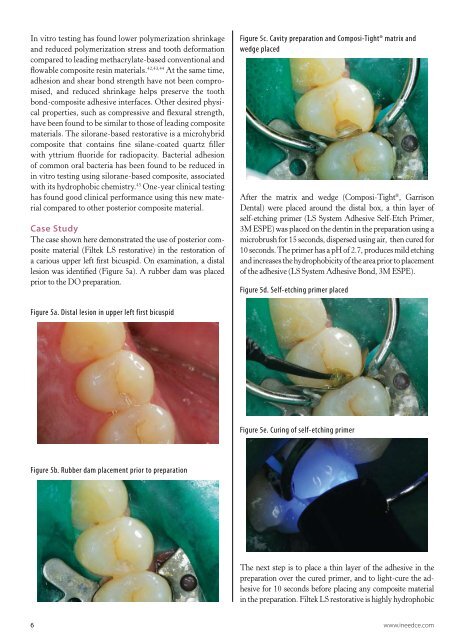The Properties and Selection of Posterior Direct ... - IneedCE.com
The Properties and Selection of Posterior Direct ... - IneedCE.com
The Properties and Selection of Posterior Direct ... - IneedCE.com
You also want an ePaper? Increase the reach of your titles
YUMPU automatically turns print PDFs into web optimized ePapers that Google loves.
In vitro testing has found lower polymerization shrinkage<br />
<strong>and</strong> reduced polymerization stress <strong>and</strong> tooth deformation<br />
<strong>com</strong>pared to leading methacrylate-based conventional <strong>and</strong><br />
flowable <strong>com</strong>posite resin materials. 42,43,44 At the same time,<br />
adhesion <strong>and</strong> shear bond strength have not been <strong>com</strong>promised,<br />
<strong>and</strong> reduced shrinkage helps preserve the tooth<br />
bond-<strong>com</strong>posite adhesive interfaces. Other desired physical<br />
properties, such as <strong>com</strong>pressive <strong>and</strong> flexural strength,<br />
have been found to be similar to those <strong>of</strong> leading <strong>com</strong>posite<br />
materials. <strong>The</strong> silorane-based restorative is a microhybrid<br />
<strong>com</strong>posite that contains fine silane-coated quartz filler<br />
with yttrium fluoride for radiopacity. Bacterial adhesion<br />
<strong>of</strong> <strong>com</strong>mon oral bacteria has been found to be reduced in<br />
in vitro testing using silorane-based <strong>com</strong>posite, associated<br />
with its hydrophobic chemistry. 45 One-year clinical testing<br />
has found good clinical performance using this new material<br />
<strong>com</strong>pared to other posterior <strong>com</strong>posite material.<br />
Case Study<br />
<strong>The</strong> case shown here demonstrated the use <strong>of</strong> posterior <strong>com</strong>posite<br />
material (Filtek LS restorative) in the restoration <strong>of</strong><br />
a carious upper left first bicuspid. On examination, a distal<br />
lesion was identified (Figure 5a). A rubber dam was placed<br />
prior to the DO preparation.<br />
Figure 5c. Cavity preparation <strong>and</strong> Composi-Tight® matrix <strong>and</strong><br />
wedge placed<br />
After the matrix <strong>and</strong> wedge (Composi-Tight ® , Garrison<br />
Dental) were placed around the distal box, a thin layer <strong>of</strong><br />
self-etching primer (LS System Adhesive Self-Etch Primer,<br />
3M ESPE) was placed on the dentin in the preparation using a<br />
microbrush for 15 seconds, dispersed using air, then cured for<br />
10 seconds. <strong>The</strong> primer has a pH <strong>of</strong> 2.7, produces mild etching<br />
<strong>and</strong> increases the hydrophobicity <strong>of</strong> the area prior to placement<br />
<strong>of</strong> the adhesive (LS System Adhesive Bond, 3M ESPE).<br />
Figure 5d. Self-etching primer placed<br />
Figure 5a. Distal lesion in upper left first bicuspid<br />
Figure 5e. Curing <strong>of</strong> self-etching primer<br />
Figure 5b. Rubber dam placement prior to preparation<br />
<strong>The</strong> next step is to place a thin layer <strong>of</strong> the adhesive in the<br />
preparation over the cured primer, <strong>and</strong> to light-cure the adhesive<br />
for 10 seconds before placing any <strong>com</strong>posite material<br />
in the preparation. Filtek LS restorative is highly hydrophobic<br />
6 www.ineedce.<strong>com</strong>
















